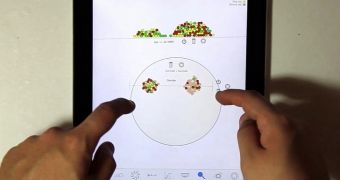The standard set of touch commands and gestures that can be recognized by an operating system is pretty good, especially in Windows 8 and Android 4.4 KitKat, but there are some things that it can’t do, like enabling easy and quick manipulation of data sheets and charts.
That's why a team of Ph.D. students at the Human-Computer Interaction Institute from Carnegie Mellon University (CMU for short) took matters into their own hands.
And we don't just mean that figuratively. They literally took matters into their own hands, or fingertips if you want to be really specific about it.
They developed Kinetica, a touch-based system that allows you to import a data set and separate outliers or specific values, or do a number of other things.
For instance, you can have a clump of data and just slide your fingers over the screen, creating a chart that automatically sorts the “dots.”
Sliding across it can help you separate values as well, as we said, and you can even distinguish data according to statistics. The Data points appear as magnetic dots of different colors, which changes based on certain chosen values.
So you cold, say, sort foods by sugar content, separate groups of people by college year, set aside cars of various colors, etc.
And because there just is no good way of expressing the usefulness and convenience of the tool in words, the students who put the Kinetica together shot a video of it in action.
You can see that the interface is very responsive, even though it's not clear how familiar you have to be with it and how long it would take to get a handle on its functions.
You can learn, though. Or you will have the chance to do it if you go and register, thus reserving a copy of the software for when it comes out, on April 29. That's less than a week away.
There's just one problem: the app only runs on the iPad, at least for now. So if you have a tablet that isn't made by Apple, or any sort of PC, you won't be able to do anything with the software at all.
Maybe later, if the Kinetica gets off the ground and sparks some sort of interest in the world at large, the creators of the app will adapt it for Windows and Android. It's not like corporate customers are likely to carry out their office tasks on an iPad after all, or any sort of tablet.
Maybe they're willing to do something of the sort on the way home or during an evening, but spreadsheets and charts usually need an actual PC, which is commonly better protected as well.

 14 DAY TRIAL //
14 DAY TRIAL //